2015浙大考博参考书目
- 格式:doc
- 大小:131.50 KB
- 文档页数:10
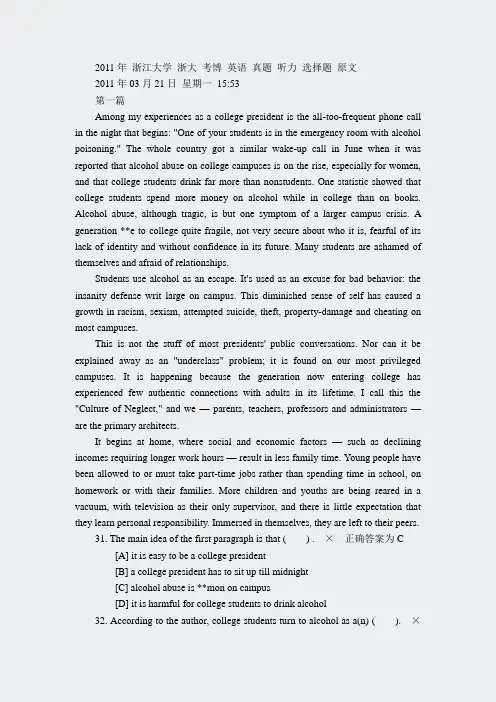
2011年浙江大学浙大考博英语真题听力选择题原文2011年03月21日星期一15:53第一篇Among my experiences as a college president is the all-too-frequent phone call in the night that begins: "One of your students is in the emergency room with alcohol poisoning." The whole country got a similar wake-up call in June when it was reported that alcohol abuse on college campuses is on the rise, especially for women, and that college students drink far more than nonstudents. One statistic showed that college students spend more money on alcohol while in college than on books. Alcohol abuse, although tragic, is but one symptom of a larger campus crisis. A generation **e to college quite fragile, not very secure about who it is, fearful of its lack of identity and without confidence in its future. Many students are ashamed of themselves and afraid of relationships.Students use alcohol as an escape. It's used as an excuse for bad behavior: the insanity defense writ large on campus. This diminished sense of self has caused a growth in racism, sexism, attempted suicide, theft, property-damage and cheating on most campuses.This is not the stuff of most presidents' public conversations. Nor can it be explained away as an "underclass" problem; it is found on our most privileged campuses. It is happening because the generation now entering college has experienced few authentic connections with adults in its lifetime. I call this the "Culture of Neglect," and we — parents, teachers, professors and administrators —are the primary architects.It begins at home, where social and economic factors —such as declining incomes requiring longer work hours — result in less family time. Young people have been allowed to or must take part-time jobs rather than spending time in school, on homework or with their families. More children and youths are being reared in a vacuum, with television as their only supervisor, and there is little expectation that they learn personal responsibility. Immersed in themselves, they are left to their peers.31. The main idea of the first paragraph is that () .×正确答案为C[A] it is easy to be a college president[B] a college president has to sit up till midnight[C] alcohol abuse is **mon on campus[D] it is harmful for college students to drink alcohol32. According to the author, college students turn to alcohol as a(n) ().×正确答案为C[A] inspiration[B] stimulation[C] escape[D] relaxation33. The word "architects" in Para. 2 can be best replaced by ().×正确答案为D[A] artists[B] experts[C] discoverers[D] designers34. How do parents react to the "Culture of Neglect"?()×正确答案为B[A] Parents have lowered their expectations on children.[B] Parents take little care of the growth of their children.[C] Parents spend too much time watching television.[D] Parents fail to cooperate with teachers and administrators.35. What is the main problem with the children brought up in the "Culture of Neglect?"()×正确答案为C[A] They can't read or write well.[B] They can hardly find a good job.[C] They don't have the sense of responsibility.[D] They are more likely to commit crimes.第二篇Conventional wisdom about conflict seems pretty much cut and dried. Too little conflict breeds apathy (冷漠) and stagnation (呆滞). Too much conflict leads to divisiveness (分裂) and hostility. Moderate levels of conflict, however, can spark creativity and motivate people in a healthy **petitive way.Recent research by Professor Charles R. Schwenk, however, suggests that the optimal level of conflict may be **plex to determine than these simple generalizations. He studied perceptions of conflict among a sample of executives. Some of the executives worked for profit-seeking organizations and others for not-for-profit organizations.Somewhat surprisingly, Schwenk found that opinions about conflict varied systematically as a function of the type of organization. Specifically, managers innot-for-profit organizations strongly believed that conflict was beneficial to their organizations and that it promoted higher quality decision making than might be achieved in the absence of conflict.Managers of for-profit organizations saw a different picture. They believed that conflict generally was damaging and usually led to poor-quality decision making in their organizations. Schwenk interpreted these results in terms of the criteria for effective decision making suggested by the executives. In the profit-seeking organizations, decision-making effectiveness was most often assessed in financial terms. The executives believed that consensus rather than conflict enhanced financial indicators.In the not-for-profit organizations, decision-making effectiveness was defined from the perspective of satisfying constituents. Given **plexities and ambiguities associated with satisfying many diverse constituents executives perceived that conflict led to more considered and acceptable decisions.31.In the eyes of the author, conventional opinion on conflict is________.A) wrongB) oversimplifiedC) misleadingD) unclear注:文章第一句32.Professor Charles R. Schwenk's research shows________.A) the advantages and disadvantages of conflictB) the real value of conflictC) the difficulty in determining the optimal level of conflictD) **plexity of defining the roles of conflict注:文章第二段33.We can learn from Schwenk's research that________.A) a person’s view of conflict is influenced by the purpose of his organizationB) conflict is necessary for managers of for-profit organizationsC) different people resolve conflicts in different waysD) it is impossible for people to avoid conflict注:文章第三段34.The passage suggests that in for - profit organizations_______.A) there is no end of conflictB) expression of different opinions is encouragedC) decisions must be justifiableD) success lies in general agreement注:文章第四段,justifiable合法化35.People working in a not - for - profit organization________.A) seem to be difficult to satisfyB) are free to express diverse opinionsC) are less effective in making decisionsD) find it easier to reach agreementB C A D B第三篇Children live in a world in which science has tremendous importance. During their lifetimes it will affect them more and more. In time, many of them will work at jobs that depend heavily on science --- for example, concerning energy sources, pollution control, highway safety, wilderness conservation, and population growth, and population growth. As taxpayers they will pay for scientific research and exploration. And, as consumers, they will be bombarded (受到轰击) by advertising, much of which is said to be based on science.Therefore, it is important that children, the citizens of the future, become functionally acquainted with science---- with the process and spirit of science, as well as with its facts and principles. Fortunately, science has a natural appeal for youngsters. They can relate it to so many things that they encounter ---- flashlights, tools, echoes, and rainbows.Besides, science is an excellent medium for teaching far more than content. It can help pupils learn to think logically, to organize and analyse ideas. It can provide practice in communication skills and mathematics. In fact, there is no area of the curriculum to which science cannot contribute, whether it be geography, history, language arts, music, or art!Above all, good science teaching leads to what might be called a “scientific attitude.” Those who possess it seek answers through observing, experimenting, and reasoning, rather than blindly accepting the pronouncements of others. They weigh evidence carefully and reach conclusions with caution. While respecting the opinions of others, they expect honesty, accuracy, and objectivity and are on guard against hasty judgments and sweeping generalizations. All children should be developing this approach to solving problems, but it cannot be expected to appear automatically with the mere acquisition of information. Continual practice, through guided participation,is needed. (293 words)36. One of the reasons why science is important for children is that many of them will _____.A. work in scientific research institutionsB. work at jobs closely related to scienceC. make the final decision in matters concerning scienceD. be fund-raisers for scientific research and exploration37. There is no doubt that children like learning science because_____.A. science is linked with many of the things they meetB. science is a very easy subject for them to learnC. they encounter the facts and principles of science dailyD. they are familiar with the process and spirit of science38. Pupils can learn logical thinking while _____.A. **munication skillsB. studying geographyC. taking art coursesD. learning science 39. People with a scientific attitude ____.A. are ready to accept the pronouncements of othersB. tend to reach conclusions with certaintyC. are aware that others are likely to make hasty judgmentsD. seek truth through observation , experimentation and reasoning 40. In the passage the writer seems to ______.A. prove that science is a successful course in schoolB. point out that science as a course is now poorly taught in schoolC. suggest that science should be included in the school curriculumD. predict that children who learn science will be good scientists36-40 B A D D C2011年浙大考博真题英语完形填空题和部分阅读原文2011年03月23日星期三13:09The United States has historically had higher rates of marriage than those of other industrialized countries. The current annual marriage 56 in the United States-about 9 new marriages for every 1,000 people-is 57 higher than it is in other industrialized countries. However, marriage is 58 as widespread as it was several decades ago. 59 of American adults who are married 60 from 72 percent in 1970 to 60percent in 2002. This does not mean that large numbers of people will remain unmarried 61 their lives. Throughout the 20th century, about 90 percent of Americans married at some 62 in their lives. Experts 63 that about the same proportion of today’s young adults will eventually marry. The timing of marriage has varied 64 over the past century. In 1995 the average age of women in the United States at the time of their first marriage was 25. The average age of men was about 27. Men and women in the United States marry for the first time an average of five years later than people did in the 1950s. 65 , young adults of the 1950s married younger than did any previous 66 in U.S. history. Today’s later age of marriage is 67 the age of marriage between 1890 and 1940. Moreover, a greater proportion of the population was married (95 percent) during the 1950s than at any time before 68 . Experts do not agree on why the “marriage rush” of the late 1940s and 1950s occurred, but most social scientists believe it represented a 69 to the return of peaceful and prosperity after 15 years of severe economic 70 and war.56. A. rate B. ratio C percentage D. poll57. A. potentially B intentionally C. randomly D.substantially58 A. not any longer B. no more C. no longer D. not any more59 A. A proportion B. The proportion C. The number D. A number60 A. declined B .deteriorated C deduced D demolished61 A past B passing C throughout D through62 A period B level C point D respect63 A project B plan C promise D propose64 A unexpectedly B irregularly C flexibly D consistently65 A Beside B However C Whereas D Nevertheless66 A descendants B ascendants C population D generation67 A according to B in line with C based D caused by68 A and after B or after C or since D ever since69 A refusal B realization C response D reality70 A repression B aggression C restriction D depression答案:56.A. 57.D . 58.C. 59.B. 60. A. 61. C. 62. C. 63. A. 64.C. 65. B..66.D . 67. B . 68 .C. 69.C 70.D阅读题目不全相同,仅供参考Tattoos didn’t spring up with the dawn of biker gangs and rock ‘n’roll bands. They’ve been around for a long time and had many different meanings over thecourse of history. For years, scientists believed that Egyptians and Nubians were the first people to tattoo their bodies. Then, in 1991, a mummy was discovered, dating back to the Bronze Age of about 3,300 B.C. “The Iceman,” as the specimen was dubbed, had several markings on his body, including a cross on the inside of his knee and lines on his ankle and back. It is believed these tattoos were made in a curative effort. Being so advance, the Egyptians reportedly spread the practice of tattooing throughout the world. The pyramid-building third and fourth dynasties of Egypt developed international nations with Crete, Greece, Persia and Arabia. The art tattooing stretched out all the way to Southeast Asia by 2,000 B.C.. Around the same time, the Japanese became interested in the art but only for its decorative attributes, as opposed to magical ones. The Japanese tattoo artists were the undisputed masters. Their use of colors, perspective, and imaginative designs gave the practice a whole new angle. During the first millennium A.D., Japan adopted Chinese culture in many aspects and confined tattooing to branding wrongdoers. In the Balkans, the Thracians had a different use for the craft. Aristocrats, according to Herodotus, used it to show the world their social status. Although early Europeans dabbled with tattooing, they truly rediscovered the art from when the world exploration of the post-Renaissance made them seek out new cultures. It was their meeting with Polynesian that introduced them to tattooing. The word, in fact is derived from the Polynesian word tattau, which means “to mark.”. Most of the early uses of tattoos were ornamental. However, a number of civilizations had practical applications for this craft. The Goths, a tribe of Germanic barbarians famous for pillaging Roman settlements, used tattoos to mark their slaves. Romans did the same with slaves and criminals. In Tahiti, tattoos were a rite of passage and told the h istory of the person’s life. Reaching adulthood, boys got one tattoo to commemorate the event. Men were marked with another style when they got married. Later, tattoos became the souvenir of choice for globetrotting sailors. Whenever they would reach an exotic locale, they would get a new tattoo to mark the occasion. A dragon was a famous style that meant the sailor had reached a “China station.” At first, sailors would spend their free time on the ship tattooing themselves and their mates. Soon after, tattoo parlors were set up in the area, surrounding ports worldwide. In the middle of the 19th century, police officials believed that half of the criminal underworld in New York City had tattoos. Port areas were renowned for being rough places full of sailors that were guilty of some crime or another. This is most likely how tattoos got such a bad reputation and became associated with rebels and delinquents.21. According to the passage, tattoos were adopted for all of the following purposes EXCEPT_______A. To treat the disease.B. To challenge social mores.C. To record the footprints of one’s life.D. To adorn oneself.22. Tattoo was believed to be created ___________.A. together with biker gangs and rock ’n’ roll bandsB. in 1991 when a mummy was discoveredC. firstly in Southeast Asia by 2,000 B.C.D. by Egyptians and Nubians23. In Japan, tattoos were accepted as ___________.A. a means of ornamentB. a symbol of magical powerC. a way of communicationD. a sign of success24. Which of the following statement is true according to the passage?A. Both China and Japan confined tattooing to marking criminals.B. Romans used tattoos for decoration.C. Sailors took tattoos as the gift for their friends and relatives.D. Tattoo parlors were usually found in downtown areas.25. Why did tattoos become associated with rebels and delinquents in New York?A. Because in the middle of the 19th century, criminals were usually tattooed by the government.B. Because sailors had tattoos and some of the sailors were guilty of some crime or another.C. Because tattoos were the marks for the members of certain organizations.D. Because Port authorities required the sailors to wear tattoos.答案bdaad。
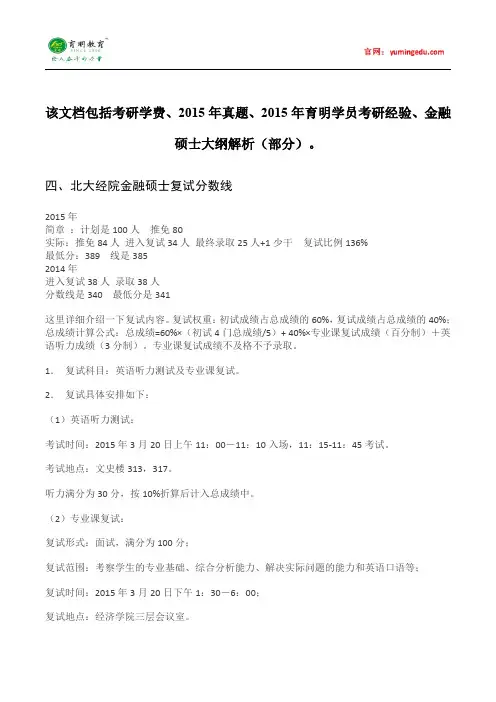
该文档包括考研学费、2015年真题、2015年育明学员考研经验、金融硕士大纲解析(部分)。
四、北大经院金融硕士复试分数线2015年简章:计划是100人推免80实际:推免84人进入复试34人最终录取25人+1少干复试比例136%最低分:389线是3852014年进入复试38人录取38人分数线是340最低分是341这里详细介绍一下复试内容。
复试权重:初试成绩占总成绩的60%,复试成绩占总成绩的40%;总成绩计算公式:总成绩=60%×(初试4门总成绩/5)+40%×专业课复试成绩(百分制)+英语听力成绩(3分制)。
专业课复试成绩不及格不予录取。
1.复试科目:英语听力测试及专业课复试。
2.复试具体安排如下:(1)英语听力测试:考试时间:2015年3月20日上午11:00-11:10入场,11:15-11:45考试。
考试地点:文史楼313,317。
听力满分为30分,按10%折算后计入总成绩中。
(2)专业课复试:复试形式:面试,满分为100分;复试范围:考察学生的专业基础、综合分析能力、解决实际问题的能力和英语口语等;复试时间:2015年3月20日下午1:30-6:00;复试地点:经济学院三层会议室。
请考生务必于20日下午1:00-1:20准时签到。
签到地点:经济学院三层307室。
经济学院地址:北京大学东侧门外向北约300米考研复试面试不用担心,育明老师有系统的专业课内容培训,日常问题培训,还要进行三次以上的模拟面试,确保你能够在面试上游刃有余,很多老师问题都是我们在模拟面试准备过的。
考研真题2015年北京大学经济学院金融硕士考研真题一、GPA=3.1+0.5TUTOR TUTOR R^2=0.08SER1.2是有家教1没有家教0(0.4)(0.36)(1)截距项的意义,斜率系数的意义,有请家教的人平均GPA为多少?(2)判断回归的合理性。
R^2的含义,SER的含义。
(3)斜率系数在5%的显著性水平上的显著吗?(4)假设回归合理。
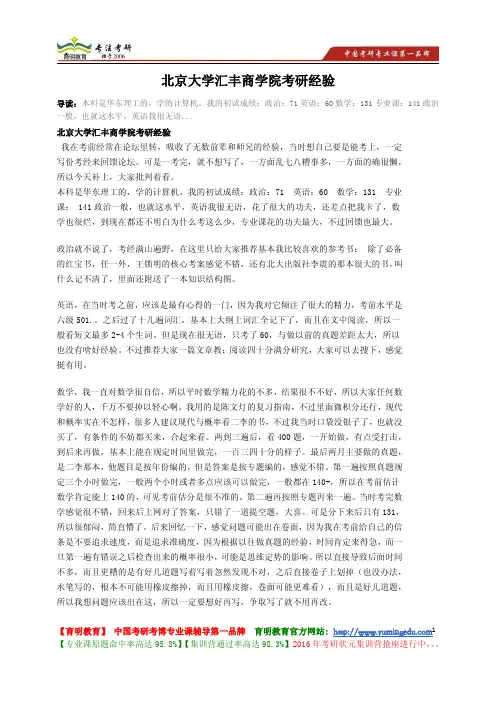
北京大学汇丰商学院考研经验导读:本科是华东理工的,学的计算机。
我的初试成绩:政治:71英语:60数学:131专业课:141政治一般,也就这水平,英语我很无语...北京大学汇丰商学院考研经验我在考前经常在论坛里转,吸收了无数前辈和师兄的经验,当时想自己要是能考上,一定写份考经来回馈论坛。
可是一考完,就不想写了,一方面乱七八糟事多,一方面的确很懒,所以今天补上,大家批判着看。
本科是华东理工的,学的计算机。
我的初试成绩:政治:71英语:60数学:131专业课:141政治一般,也就这水平,英语我很无语,花了很大的功夫,还差点把我卡了,数学也很烂,到现在都还不明白为什么考这么少,专业课花的功夫最大,不过回馈也最大。
政治就不说了,考经满山遍野,在这里只给大家推荐基本我比较喜欢的参考书:除了必备的红宝书,任一外,王锁明的核心考案感觉不错,还有北大出版社李震的那本很大的书,叫什么记不清了,里面还附送了一本知识结构图。
英语,在当时考之前,应该是最有心得的一门,因为我对它倾注了很大的精力,考前水平是六级501.。
之后过了十几遍词汇,基本上大纲上词汇全记下了,而且在文中阅读,所以一般看短文最多2-4个生词。
但是现在很无语,只考了60,与做以前的真题差距太大,所以也没有啥好经验。
不过推荐大家一篇文章教:阅读四十分满分研究,大家可以去搜下,感觉挺有用。
数学,我一直对数学很自信,所以平时数学精力花的不多,结果很不不好,所以大家任何数学好的人,千万不要掉以轻心啊。
我用的是陈文灯的复习指南,不过里面微积分还行,现代和概率实在不怎样,很多人建议现代与概率看二李的书,不过我当时口袋没银子了,也就没买了,有条件的不妨都买来,合起来看。
两到三遍后,看400题,一开始做,有点受打击,到后来再做,基本上能在规定时间里做完,一百三四十分的样子。
最后两月主要做的真题,是二李那本,他题目是按年份编的,但是答案是按专题编的,感觉不错。
第一遍按照真题规定三个小时做完,一般两个小时或者多点应该可以做完,一般都在140+,所以在考前估计数学肯定能上140的,可见考前估分是很不准的。

浙大经济学院考博试题政治经济学西方经济学
Document serial number【UU89WT-UU98YT-UU8CB-UUUT-UUT108】
政治经济学
一简答题(每题10分)
1 马克思的分工理论;
2 马克思主义的历史与逻辑统一的分析方法;
3 马克思的生产性劳动与非生产性劳动理论;
4 资本周转理论;
二论述题(每题20分)
1 利用资本积累的一般规律解释我国现阶段的两极分化现象;
2 利用新制度经济学分析和解释马克思主义的经典理论;
3 说明经济增长方式的转变与制度变迁的关系;
西方经济学
一计算题(每题10分)
1 索罗模型的基本计算,以及黄金率问题的计算;
2 斯坦克尔博格模型的计算;
二简答题(每题10分)
1 说明埃奇沃斯曲线;
2 说明超优策略;
3 说明IS-LM模型的稳定性条件;
4 推导卢卡斯总供给曲线;
三论述题(每题20分)
1 说明逆向选择问题;。
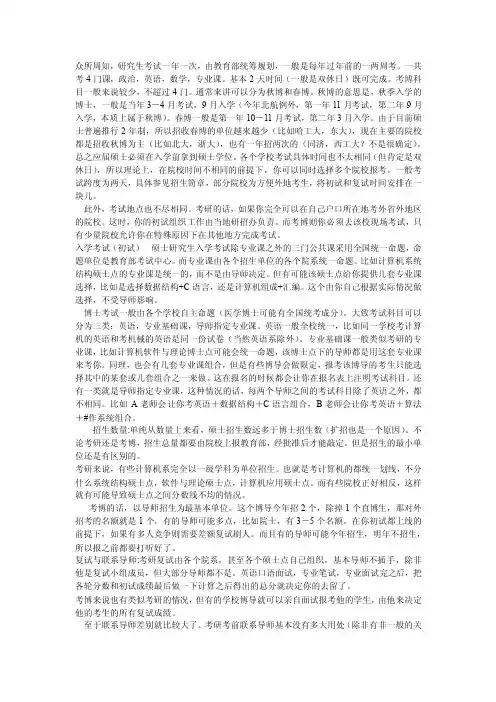
众所周知,研究生考试一年一次,由教育部统筹规划,一般是每年过年前的一两周考。
一共考4门课,政治,英语,数学,专业课。
基本2天时间(一般是双休日)既可完成。
考博科目一般来说较少,不超过4门。
通常来讲可以分为秋博和春博。
秋博的意思是,秋季入学的博士,一般是当年3-4月考试,9月入学(今年北航例外,第一年11月考试,第二年9月入学,本质上属于秋博)。
春博一般是第一年10-11月考试,第二年3月入学。
由于目前硕士普遍推行2年制,所以招收春博的单位越来越少(比如哈工大,东大),现在主要的院校都是招收秋博为主(比如北大,浙大),也有一年招两次的(同济,西工大?不是很确定)。
总之应届硕士必须在入学前拿到硕士学位。
各个学校考试具体时间也不太相同(但肯定是双休日),所以理论上,在院校时间不相同的前提下,你可以同时选择多个院校报考。
一般考试跨度为两天,具体参见招生简章,部分院校为方便外地考生,将初试和复试时间安排在一块儿。
此外,考试地点也不尽相同。
考研的话,如果你完全可以在自己户口所在地考外省外地区的院校。
这时,你的初试组织工作由当地研招办负责。
而考博则你必须去该校现场考试,只有少量院校允许你在特殊原因下在其他地方完成考试。
入学考试(初试)硕士研究生入学考试除专业课之外的三门公共课采用全国统一命题,命题单位是教育部考试中心。
而专业课由各个招生单位的各个院系统一命题。
比如计算机系统结构硕士点的专业课是统一的,而不是由导师决定。
但有可能该硕士点给你提供几套专业课选择,比如是选择数据结构+C语言,还是计算机组成+汇编。
这个由你自己根据实际情况做选择,不受导师影响。
博士考试一般由各个学校自主命题(医学博士可能有全国统考成分)。
大致考试科目可以分为三类:英语,专业基础课,导师指定专业课。
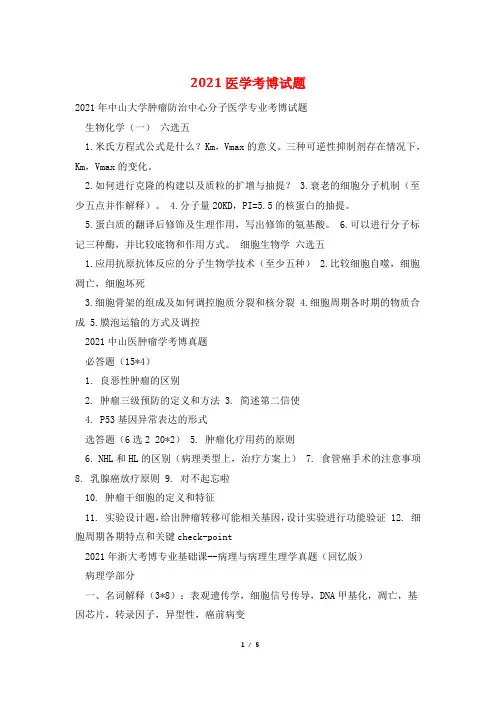
2021医学考博试题2021年中山大学肿瘤防治中心分子医学专业考博试题生物化学(一)六选五1.米氏方程式公式是什么?Km,Vmax的意义。
三种可逆性抑制剂存在情况下,Km,Vmax的变化。
2.如何进行克隆的构建以及质粒的扩增与抽提?3.衰老的细胞分子机制(至少五点并作解释)。
4.分子量20KD,PI=5.5的核蛋白的抽提。
5.蛋白质的翻译后修饰及生理作用,写出修饰的氨基酸。
6.可以进行分子标记三种酶,并比较底物和作用方式。
细胞生物学六选五1.应用抗原抗体反应的分子生物学技术(至少五种)2.比较细胞自噬,细胞凋亡,细胞坏死3.细胞骨架的组成及如何调控胞质分裂和核分裂4.细胞周期各时期的物质合成5.膜泡运输的方式及调控2021中山医肿瘤学考博真题必答题(15*4)1. 良恶性肿瘤的区别2. 肿瘤三级预防的定义和方法3. 简述第二信使4. P53基因异常表达的形式选答题(6选2 20*2) 5. 肿瘤化疗用药的原则6. NHL和HL的区别(病理类型上,治疗方案上)7. 食管癌手术的注意事项8. 乳腺癌放疗原则9. 对不起忘啦10. 肿瘤干细胞的定义和特征11. 实验设计题,给出肿瘤转移可能相关基因,设计实验进行功能验证 12. 细胞周期各期特点和关键check-point2021年浙大考博专业基础课--病理与病理生理学真题(回忆版)病理学部分一、名词解释(3*8):表观遗传学,细胞信号传导,DNA甲基化,凋亡,基因芯片,转录因子,异型性,癌前病变二、简答题(六选三,3*12): 1.简述病毒与肿瘤的关系。
2.请简述肿瘤的分子分型。
3.目前结直肠癌发生的分子机制有几种,请你谈谈你的评价。
4.消化道常见的溃疡性病变有哪些(至少4种)及其病理学特点及鉴别要点。
5.肿瘤上皮间质转化(EMT)的概念,它与肿瘤存在哪些联系,谈谈你所了解的机制。
6.免疫组织化学技术的概念及其应用范围。
病理生理学部分(四选二,2*20)1.抑癌基因失活的机制有哪些?请举例说明其在肿瘤发生发展中的作用。
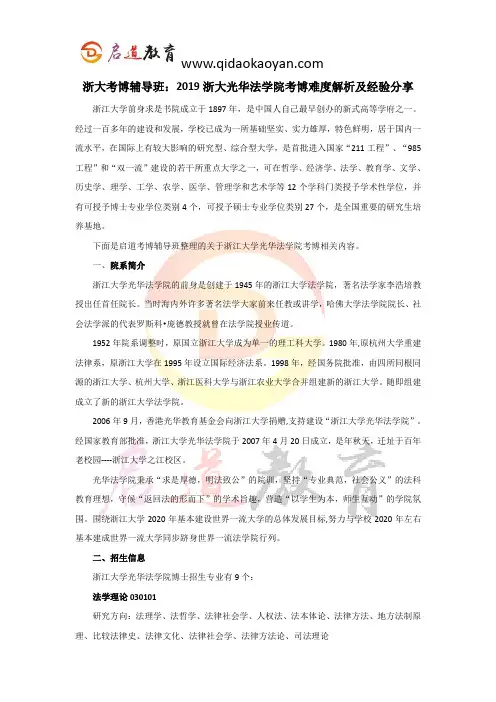
浙大考博辅导班:2019浙大光华法学院考博难度解析及经验分享浙江大学前身求是书院成立于1897年,是中国人自己最早创办的新式高等学府之一。
经过一百多年的建设和发展,学校已成为一所基础坚实、实力雄厚,特色鲜明,居于国内一流水平,在国际上有较大影响的研究型、综合型大学,是首批进入国家“211工程”、“985工程”和“双一流”建设的若干所重点大学之一,可在哲学、经济学、法学、教育学、文学、历史学、理学、工学、农学、医学、管理学和艺术学等12个学科门类授予学术性学位,并有可授予博士专业学位类别4个,可授予硕士专业学位类别27个,是全国重要的研究生培养基地。
下面是启道考博辅导班整理的关于浙江大学光华法学院考博相关内容。
一、院系简介浙江大学光华法学院的前身是创建于1945年的浙江大学法学院,著名法学家李浩培教授出任首任院长。
当时海内外许多著名法学大家前来任教或讲学,哈佛大学法学院院长、社会法学派的代表罗斯科•庞德教授就曾在法学院授业传道。
1952年院系调整时,原国立浙江大学成为单一的理工科大学。
1980年,原杭州大学重建法律系,原浙江大学在1995年设立国际经济法系。
1998年,经国务院批准,由四所同根同源的浙江大学、杭州大学、浙江医科大学与浙江农业大学合并组建新的浙江大学。
随即组建成立了新的浙江大学法学院。
2006年9月,香港光华教育基金会向浙江大学捐赠,支持建设“浙江大学光华法学院”。
经国家教育部批准,浙江大学光华法学院于2007年4月20日成立,是年秋天,迁址于百年老校园----浙江大学之江校区。
光华法学院秉承“求是厚德,明法致公”的院训,坚持“专业典范,社会公义”的法科教育理想,守候“返回法的形而下”的学术旨趣,营造“以学生为本,师生互动”的学院氛围。
围绕浙江大学2020年基本建设世界一流大学的总体发展目标,努力与学校2020年左右基本建成世界一流大学同步跻身世界一流法学院行列。
二、招生信息浙江大学光华法学院博士招生专业有9个:法学理论030101研究方向:法理学、法哲学、法律社会学、人权法、法本体论、法律方法、地方法制原理、比较法律史、法律文化、法律社会学、法律方法论、司法理论宪法学与行政法学030103研究方向:行政法基础理论、比较行政法学、行政诉讼法学、行政法学、政府管制研究、行政审判原理与实务、行政法基础理论、新行政法学、行政诉讼法学、立法学、宪法司法适用与宪法制度变迁、公法理论与法学方法、行政法学、福利法、公法与政策研究、行政法学、行政诉讼法学、国家赔偿法学民商法学030105研究方向:民法学、法律社会学、民法学、民法学、法学方法论、民法学、商法学、民法学、社会保障法、法社会学、民商法学、民法学、法学方法论诉讼法学030106研究方向:刑事诉讼法学、证据法学、司法制度、民事诉讼法学、民事诉讼法学、司法制度、刑事诉讼法学经济法学030107研究方向:投资融资法、基金和证券法、金融犯罪、公司金融法、资本市场法(含证券法)、金融刑法巩固环境资源法、知识产权法、科技法、娱乐法、知识产权法、金融法、法律经济学、国际经济法国际法学030109研究方向:国际经济法、国际投资法、国际贸易法、国际经济法、国际法、比较法、国际经济法、国际商事仲裁法、国际私法、国际经济法(贸易与竞争、区域经济一体化等)、国际法、国际经济法、国际争端解决、国际法、国际经济法、国际私法海洋法学0301Z2研究方向海洋法学、国际法学、海洋法学刑法学030104研究方向:刑法解释学、刑事政策学、经济刑法学司法文明0301Z3研究方向:司法文明基础理论、法理学、法哲学三、报考条件1.基本要求(1)拥护中国共产党的领导,具有正确的政治方向,热爱祖国,愿意为社会主义现代化建设服务,遵纪守法,品行端正。
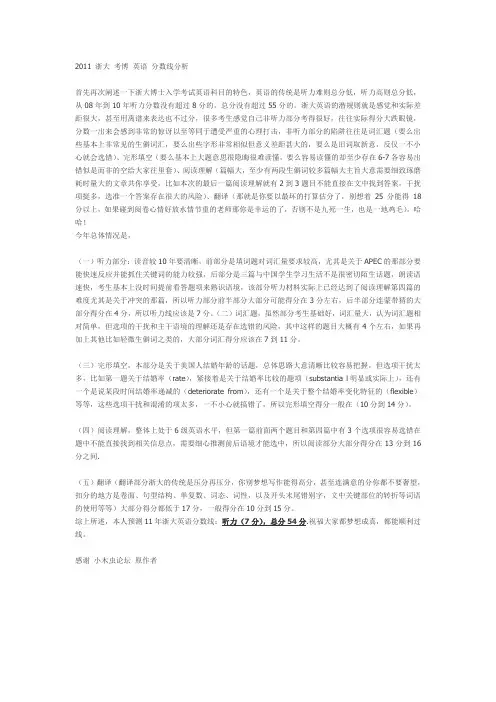
2011 浙大考博英语分数线分析首先再次阐述一下浙大博士入学考试英语科目的特色,英语的传统是听力难则总分低,听力高则总分低,从08年到10年听力分数没有超过8分的,总分没有超过55分的。
浙大英语的潜规则就是感觉和实际差距很大,甚至用离谱来表达也不过分,很多考生感觉自己非听力部分考得很好,往往实际得分大跌眼镜,分数一出来会感到非常的惊讶以至等同于遭受严重的心理打击,非听力部分的陷阱往往是词汇题(要么出些基本上非常见的生僻词汇,要么出些字形非常相似但意义差距甚大的,要么是旧词取新意,反仅一不小心就会选错)、完形填空(要么基本上大题意思很隐晦很难读懂,要么容易读懂的却至少存在6-7各容易出错似是而非的空给大家往里套)、阅读理解(篇幅大,至少有两段生僻词较多篇幅大主旨大意需要细致琢磨耗时量大的文章共你享受,比如本次的最后一篇阅读理解就有2到3题目不能直接在文中找到答案,干扰项挺多,选准一个答案存在很大的风险)、翻译(那就是你要以最坏的打算估分了,别想着25分能得18分以上,如果碰到阅卷心情好放水情节重的老师那你是幸运的了,否则不是九死一生,也是一地鸡毛),哈哈!今年总体情况是,(一)听力部分:读音较10年要清晰,前部分是填词题对词汇量要求较高,尤其是关于APEC的那部分要能快速反应并能抓住关键词的能力较强,后部分是三篇与中国学生学习生活不是很密切陌生话题,朗读语速快,考生基本上没时间提前看答题项来熟识语境,该部分听力材料实际上已经达到了阅读理解第四篇的难度尤其是关于冲突的那篇,所以听力部分前半部分大部分可能得分在3分左右,后半部分连蒙带猜的大部分得分在4分,所以听力线应该是7分。
(二)词汇题,虽然部分考生基础好,词汇量大,认为词汇题相对简单,但选项的干扰和主干语境的理解还是存在选错的风险,其中这样的题目大概有4个左右,如果再加上其他比如轻微生僻词之类的,大部分词汇得分应该在7到11分。
(三)完形填空,本部分是关于美国人结婚年龄的话题,总体思路大意清晰比较容易把握,但选项干扰太多,比如第一题关于结婚率(rate),紧接着是关于结婚率比较的题项(substantia l明显或实际上),还有一个是说某段时间结婚率递减的(deteriorate from),还有一个是关于整个结婚率变化特征的(flexible)等等,这些选项干扰和混淆的项太多,一不小心就搞错了,所以完形填空得分一般在(10分到14分)。
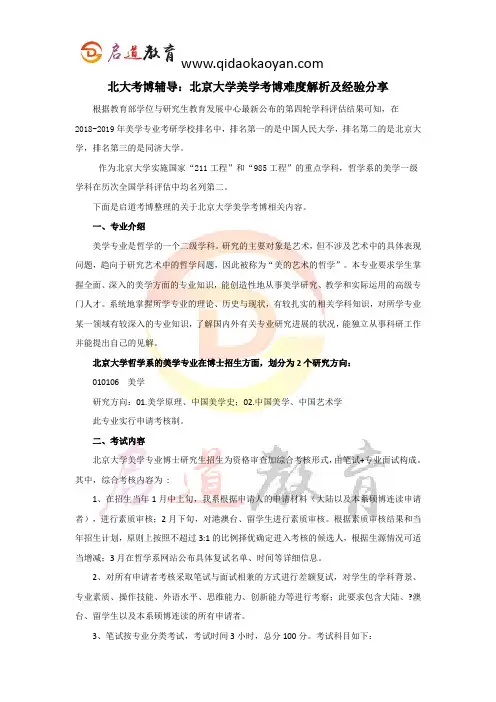
北大考博辅导:北京大学美学考博难度解析及经验分享根据教育部学位与研究生教育发展中心最新公布的第四轮学科评估结果可知,在2018-2019年美学专业考研学校排名中,排名第一的是中国人民大学,排名第二的是北京大学,排名第三的是同济大学。
作为北京大学实施国家“211工程”和“985工程”的重点学科,哲学系的美学一级学科在历次全国学科评估中均名列第二。
下面是启道考博整理的关于北京大学美学考博相关内容。
一、专业介绍美学专业是哲学的一个二级学科。
研究的主要对象是艺术,但不涉及艺术中的具体表现问题,趋向于研究艺术中的哲学问题,因此被称为“美的艺术的哲学”。
本专业要求学生掌握全面、深入的美学方面的专业知识,能创造性地从事美学研究、教学和实际运用的高级专门人才。
系统地掌握所学专业的理论、历史与现状,有较扎实的相关学科知识,对所学专业某一领域有较深入的专业知识,了解国内外有关专业研究进展的状况,能独立从事科研工作并能提出自己的见解。
北京大学哲学系的美学专业在博士招生方面,划分为2个研究方向:010106 美学研究方向:01.美学原理、中国美学史;02.中国美学、中国艺术学此专业实行申请考核制。
二、考试内容北京大学美学专业博士研究生招生为资格审查加综合考核形式,由笔试+专业面试构成。
其中,综合考核内容为:1、在招生当年1月中上旬,我系根据申请人的申请材料(大陆以及本系硕博连读申请者),进行素质审核;2月下旬,对港澳台、留学生进行素质审核。
根据素质审核结果和当年招生计划,原则上按照不超过3:1的比例择优确定进入考核的候选人,根据生源情况可适当增减;3月在哲学系网站公布具体复试名单、时间等详细信息。
2、对所有申请者考核采取笔试与面试相兼的方式进行差额复试,对学生的学科背景、专业素质、操作技能、外语水平、思维能力、创新能力等进行考察;此要求包含大陆、?澳台、留学生以及本系硕博连读的所有申请者。
3、笔试按专业分类考试,考试时间3小时,总分100分。
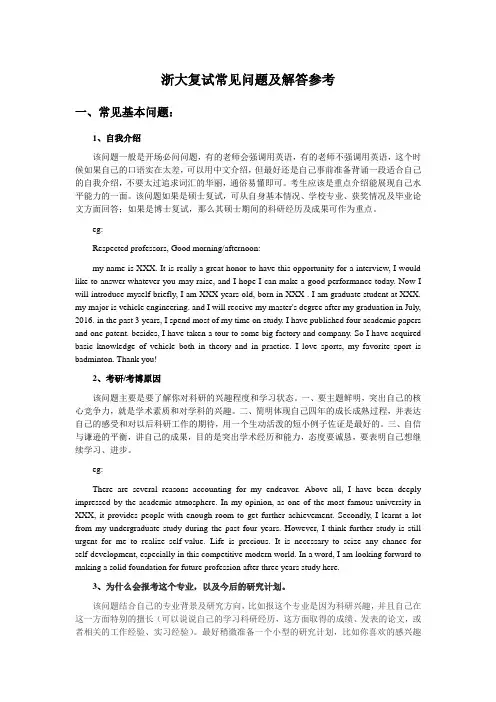
浙大复试常见问题及解答参考一、常见基本问题:1、自我介绍该问题一般是开场必问问题,有的老师会强调用英语,有的老师不强调用英语,这个时候如果自己的口语实在太差,可以用中文介绍,但最好还是自己事前准备背诵一段适合自己的自我介绍,不要太过追求词汇的华丽,通俗易懂即可。
考生应该是重点介绍能展现自己水平能力的一面。
该问题如果是硕士复试,可从自身基本情况、学校专业、获奖情况及毕业论文方面回答;如果是博士复试,那么其硕士期间的科研经历及成果可作为重点。
eg:Respected professors, Good morning/afternoon:my name is XXX. It is really a great honor to have this opportunity for a interview, I would like to answer whatever you may raise, and I hope I can make a good performance today. Now I will introduce myself briefly, I am XXX years old, born in XXX . I am graduate student at XXX. my major is vehicle engineering. and I will receive my master's degree after my graduation in July, 2016. in the past 3 years, I spend most of my time on study. I have published four academic papers and one patent. besides, I have taken a tour to some big factory and company. So I have acquired basic knowledge of vehicle both in theory and in practice. I love sports, my favorite sport is badminton. Thank you!2、考研/考博原因该问题主要是要了解你对科研的兴趣程度和学习状态。
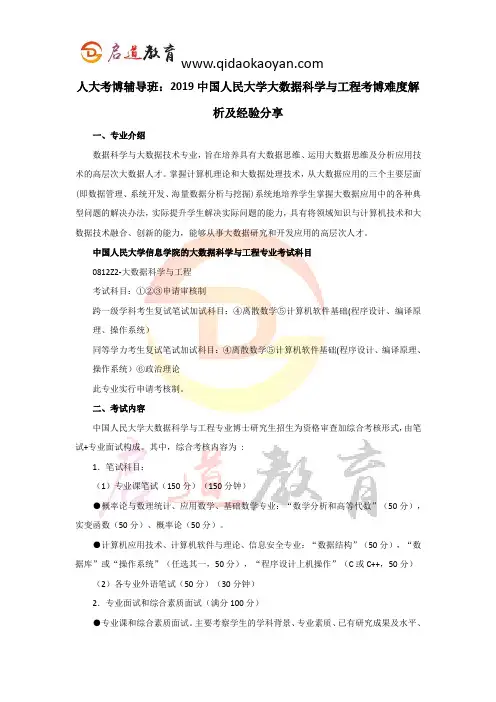
人大考博辅导班:2019中国人民大学大数据科学与工程考博难度解析及经验分享一、专业介绍数据科学与大数据技术专业,旨在培养具有大数据思维、运用大数据思维及分析应用技术的高层次大数据人才。
掌握计算机理论和大数据处理技术,从大数据应用的三个主要层面(即数据管理、系统开发、海量数据分析与挖掘)系统地培养学生掌握大数据应用中的各种典型问题的解决办法,实际提升学生解决实际问题的能力,具有将领域知识与计算机技术和大数据技术融合、创新的能力,能够从事大数据研究和开发应用的高层次人才。
中国人民大学信息学院的大数据科学与工程专业考试科目0812Z2-大数据科学与工程考试科目:①②③申请审核制跨一级学科考生复试笔试加试科目:④离散数学⑤计算机软件基础(程序设计、编译原理、操作系统)同等学力考生复试笔试加试科目:④离散数学⑤计算机软件基础(程序设计、编译原理、操作系统)⑥政治理论此专业实行申请考核制。
二、考试内容中国人民大学大数据科学与工程专业博士研究生招生为资格审查加综合考核形式,由笔试+专业面试构成。
其中,综合考核内容为:1.笔试科目:(1)专业课笔试(150分)(150分钟)●概率论与数理统计、应用数学、基础数学专业:“数学分析和高等代数”(50分),实变函数(50分)、概率论(50分)。
●计算机应用技术、计算机软件与理论、信息安全专业:“数据结构”(50分),“数据库”或“操作系统”(任选其一,50分),“程序设计上机操作”(C或C++,50分)(2)各专业外语笔试(50分)(30分钟)2.专业面试和综合素质面试(满分100分)●专业课和综合素质面试。
主要考察学生的学科背景、专业素质、已有研究成果及水平、外语听力和口语水平、思维能力、创新能力、综合运用所学知识的能力、及其对本学科前沿知识及最新研究动态的掌握情况。
3.外语听力水平和口试水平测试(满分50分)●外语口试测试考生基本的听说能力,重点检测考生是否基本掌握外语工具。
北大考博辅导:北京大学数据科学(公共卫生与预防医学)考博难度解析及经验分享根据教育部学位与研究生教育发展中心最新公布的第四轮学科评估结果可知,全国共有37所开设公共卫生与预防医学类专业的大学参与了排名,其中排名第一的是南京医科大学,排名第二的是华中科技大学,排名第三的是北京大学。
作为北京大学实施国家“211工程”和“985工程”的重点学科,前沿交叉学科研究院的数据科学(公共卫生与预防医学)一级学科在历次全国学科评估中均名列第三。
下面是启道考博整理的关于北京大学数据科学(公共卫生与预防医学)考博相关内容。
一、专业介绍公共卫生与预防医学是从医学中分化出来的一个独立的学科群。
它以人类群体为研究对象,应用生物医学、环境医学和社会医学的理论,宏观与微观相结合的方法,研究疾病发生与分布规律以及影响健康的各种因素,制定预防对策和措施,达到预防疾病、促进健康和提高生命质量的目的。
作为医学的重要组成部分,预防医学是在人类为求生存和发展、与危害健康的各种因素斗争的过程中产生和发展起来的。
北京大学前沿交叉学科研究院的数据科学(公共卫生与预防医学)专业在博士招生方面,不区分研究方向1004J3 数据科学(公共卫生与预防医学)研究方向:00.不区分研究方向此专业实行申请考核制。
二、考试内容北京大学数据科学(公共卫生与预防医学)专业博士研究生招生为资格审查加综合考核形式,由笔试+专业面试构成。
其中,综合考核内容为:1、我院各专业招生专家小组根据申请人的申请材料,参考申请者提交的课程成绩、硕士学位论文、外语水平、科研参与、发表论文、专著出版、获奖情况、研究计划和专家推荐意见等,对其科研潜质和基本素质等做出综合评价结论。
根据素质审核结果,择优确定进入考核的候选人;2、考核采取面试、笔试或两者相兼的方式进行差额复试,对学生的学科背景、专业素养、操作技能、外语水平、思维能力、创新能力以及申请人分析、解决问题和进行创新的综合能力等进行考察;3、考核时间各招生专业依据实际情况进行,外国语言文学(区域与国别)专业与生物学专业的复试时间预计安排在2019年4月,大数据类专业预计安排在3月中下旬,具体时间见后续通知。
2016协和医学院病理学真题回忆一、名词解释6分×8题:①metaplasia、②opsonin、③Tetralogy of Fallot、④Zollinger-Ellison综合征、⑤tubercle、⑥chloroma、⑦MEN、⑧Verocay小体二、单选1分×30题急性普通性肝炎的镜下改变胰腺癌早期转移途径痰涂片检出率最高的肺癌类型食管癌好发部位:中段>下段>上段猝死好发于:缺血性心脏病or心律失常风湿性心脏病赘生物好发于哪个瓣膜哪个部位病例题:葡萄胎?恶性葡萄胎?子宫内膜癌?葡萄胎的特点B细胞淋巴瘤乳头血性溢液:导管内乳头状瘤Negri bodies:狂犬病毒形成的包涵体三、简答8分×4题:1.溃结和克罗恩病区别2.风湿病对心脏的影响3.子宫内膜癌I型与II型区别4.胃肠胰神经内分泌瘤定义,其分级和免疫组化的意义以及病理报告包括啥四、问答20分×2题:1.中年女性,低分化胃癌,伴有阴道出血2月,查体及超声显示双侧卵巢大,子宫不大,CEA高。
三个问题:①进展型胃癌分型,转移途径,②卵巢肿瘤可能的类型,③结合病例,卵巢病变最可能是啥2.非浸润性乳头状尿路上皮肿瘤分类,组织学表型及此分类的意义2016年南方医科大学神经外科博士试题-神经解剖一:简答题1.神经活动的形式是什么?其结构基础是?2.是否可根据脊柱损伤来推断脊髓损伤节段?3.光反射的传导通路?4.内囊血肿会损伤那些结构,其结果?5.股神经的走行及体表投影6.深浅感觉的异同点。
二:简答题1.面神经的成分,结构,分支及损伤后有哪些表现。
2.54岁患者突发右侧上下肢偏瘫,膝跳反射亢进,巴氏征阳性,面部以下深浅感觉消失,腹壁反射减弱,考虑那个部位损伤,试简述其结构。
3.左足被蚊虫叮咬,右手去打蚊虫,试述其传道通路。
4.十二对脑神经出入颅位置及途径5.手神经的组成北京协和,病理生理,刚回旅舍整理出来的南京医科大学第一附属医院,外科学专业病理生理学真题回忆简答题(6题)钙超载在缺血—再灌注中的作用应激时交感—肾上腺髓质系统兴奋对机体的作用腺苷酸环化酶在信号转导通路中的作用应激性溃疡的发生机制临床输血和输液时常发生高热,简述其原因心力衰竭时心率加快的机制,对心功能的影响问答题(2题)严重代谢性酸中毒引起DIC的机制并简述出血的原因什么是肝性脑病?肝性脑病血氨增高的机制?临床中有何降血氨措施哈尔滨医科大学免疫一名解抗原,单克隆抗体,MAC,细胞因子,MHC限制性,PRR,免疫调节,调理作用,凝集反应,M细胞。
考博复试最容易被问到的九个英文提问回答示例Question 1:Tell us more about yourself.Do say:I’ve always been interested in discovering how things work, but my time as an undergraduate opened my eyes to the excitement and wider benefit of science. I had the chance to do some original research on my Masters and that’s inspired me to take up the challenge of a PhD. I’m also a keen hiker and amateur naturalist, so I’d love to combine my studies here with the chance to visit the local area.Don't say:I was born in a small countryside city of Jiangsu Province. My first dog was called Wangcai. At school my best friend was Liming. I like reading and listening to music in my spare time. My favourite colour is blue.Question 2:What made you choose to do a PhD?Do say:I’ve enjoyed my academic work so far, but I really feel I’ve got more to offer as an independent researcher. I’m also passionate about this subject and don’t feel enough attention has been paid to the questions I’m looking to address.Don't say:I can’t think of anything to do with my Masters, but my current tutor says I’m clever enough for a PhD.Question 3:What do you plan to do after you complete your PhD?Do say:I feel my PhD project can open up new lines of inquiry for this field and want to use it as the foundation for a fruitful research career. But, I’m also interested in the wider development opportunities included in this doctoral programme. I want to be an academic, bu t I’m happy to keep other options open.Don't say:I expect someone will give me a job doing more research. That’s what PhDs do, right?Question 4:What are your strengths and weaknesses?Do say:I feel that I’m a good written communicator. My existing academic and professional work demonstrates an ability to put forward ideas clearly and concisely. I think this will help me manage the weight of information my PhD research needs to cover and the challenge of producing an effective thesis. But, I’m not always as organised as I’d like to be. I want to address this as part of my postgraduate training and hope to take advantage of classes and development opportunities early in my doctorate.Don't say:My greatest strength is that I have no weaknesses! And my only weakness is that I have no strengths. Hang on...Question 5:Are there any training needs you can identify ahead of your PhD?Do say:I’m really interested in communicating my research to a wider audience, but don’t know how best to go about doing this. I think the training module on public engagement will be a big help to me, both academically and more generally.Don't say:I’m really bad at interviews. Do you have a class for that?Question 6:What makes you the right candidate for this PhD?Do say:I’ve been interested in this topic since the final year of my undergraduate degree. This lead to my choice of Masters and helped me pick my dissertation topic, which I really enjoye d. I’m really excited to now go on and do some sustained research in this area as a PhD student.Don't say:Well, it's quite difficult to find a good job without a doctor's degree...Question 7:What difficulties do you expect to encounter during this project?Do say:I can see that some of the archival material I’ll need to examine for this project may be difficult to access. My first task will be to request permissions, arrange visits and develop a system for recording my findings. I’m hoping to undertake training in archival practices and seek advice from my supervisor as I develop these key skills early in my project.Don't say:Yeah, I know a PhD is hard, but I’m just going to see how I get on.Question 8:Why have you chosen to study a PhD at this university?Do say:I’ve looked at lots of opportunities in this area. I feel that this project is the best of its kind, combining a unique research angle with a training programme that will meet my professional needs. I was already familiar with the work of my prospective supervisor and their research has greatly informed my own development as a scholar. I’m eager to combine my work with theirs and make use of the facilities the university has put together for this project.Don't say:I did my Masters here and already have a flat in the city.Question 9:What can you bring to this research group?Do say:I’m eager to take advantage of the facilities and expertise this university has to offer. But I also want to contribute with my own expertise and enthusiasm. My previous work has given me the skills to make the most of the material involved in this project and I’m motivated to take up new training opportunities as relevant. I’ll be proud to be a part of this department and would actively seek to represent it through my own publications and other research outputs.Don't say:I have a Bachelors and a Masters in this subject so I’m quite clever.2018考博复试常见问题考博复试面试阶段提前准备考博复试常见为题有助于考博生放松心态,新东方在线考博频道整理了2018考博复试常见问题供大家参考。
08听力1、human society2、the raw organism3、a special case4、the naked body5、normally-clothed bodies6、in the 1960s—1970s7、a precarious living8、the study of nature9、European thinking about environment10、the depletion of forest11-20CBCD CBBD CA词汇题答案:21A 22B 23C 24C 25C 26B 27A 28A 29C 30A 31B 32A 33A 34B 35A 完形填空原文及相应答案The energy crisis, which is being felt around the world, has dramatized how the careless use of the earth's resources has brought the whole world to the drink of disaster. The overdevelopment of motor transport, with its increase of more cars, more highways, more pollution, more suburbs, more commuting, has contributed to the near-destruction of our cities, the breakup of the family, and the pollution not only of local air but slao of the earth's atmosphere. The disaster has arrived in the form of the energy crisis.Our present situation is unlike war, revolution or depression. It is also unlike the great natural disasters of the past. Worldwide resources exploitation and energy use have brought us to a state where long-range planning is essential. What we need is not a continuation of our present serious state, which endangers the future of our country, our children, and our earth, but a movement forward to a new norm in order to work rapidly and effectively on planetary problems.This country has been falling back under the continuing exposures of loss morality and the revelation that lawbreaking has reached into the highest places in the land. There is a strong demand for moral revival and for some devotion that is vast enough and yet personal enough to enlist the devotion of all. In the past it has been only in a way in defense of their own country and their own ideals that any people have been able to devote themselves wholeheartedly.This is the first time that we have been asked to defend ourselves and what we hold dear in cooperation with all the other inhabitants of this planet, who share withus the same endangered air and the same endangered oceans. There is a common need ti reassess our present course, to change that coursem and to devise new methods through which the world can survive. This is a preiceless opportunity.36B 37B 38C 39A 40D 41A 42D 43B 44A 45C 46D 47A 48B 49C 50D51C 52D 53B 54A 55B08考博英语第二篇阅读题及答案Every dream is a message from your unconscious self,expressed in a code which only you can understand and interpret.The images,colours,moods and terms of your dreams depend on your culture,upbringing,slang and your own understanding of things and values.Dreaming is like looking into a mirror and seeing yourself with your own eyes. The first dreams which we have after falling asleep often revolve around the day’s events.We go through them,sorting out and discarding things we don’t need to remember and gaining insight into those we do.Often,we are inspired with suggestions that we can use to remedy the situations that plague us by day.As we progress through the night’s dreams,they may take up more fantastic quanlities,offering fanciful experience.These often pleasant images can relieve the stress of the day.But the dream we have just before the awakening often contains information the subconscious mind wants to make known to the conscious.And this information,if remembered,interpreted,and understood,can serve as an important tool in our lives.Depending upon the content,dreams can strike us with their peculiarty,or sometimes even their alarming nature.Some dreams haunt us for years,not only because of their persisitence,but also primarily because we cannot explain or understand them.Other dreams stand out with the weird mixture of images,emotions and context,which make us remember them for life.Recurring dreams are quite common,and we are facing the same problem over and over again.A recurring dream is often a sign of some emotional weakness in our nature,which causes us problems over the years.Lucid dreams are rare,but they are all about people’s ablility to control heir dreams.In such a dream,the dreamers becomes consciously aware that she/he is dreaming and is able to use the memory and participate in dream actions and emotions.Lucid dreams are usually enhanced in a sensory and imaginary way,and sometimes can be accompanied by pleasant music.People can learn the techniques of controlling their dreams.Some historic manuscripts and records say that the ability to control dreams helps a person to reach a higher degree of mind development.Thisis what some Tibetan Buddhists and Islam followers practiced for the purpose of elevation in consciousness.1.dreams can only be understood by the dreamer because____.[A] they are always based on your deep feelings.[B]they are expressed in a code only you can understand.[C]they are always something related to your upbringing.[D]they are related to your personal culture.2.According to the author, dreams____[A] are always about the days events,sorting out them one by one.[B]are primarily meant to relieve the stress of the day.[C]are only important at the stage just before you wake up.[D]move from different stages,each with different functions.3.Recurring dreams occur_____[A] because of a repetition of event,problem or emotional weakness.[B]because of a certain life situation that causes us stress.[C]because we are emotionally weak.[D]because we can not explain them.4.The word “lucid”(Line 1,Para 4) refers to ____[A] highly conscious[B]understandable[C]easy to remember[D]clearly presented5.It can be concluded from the passage that dreams offer us the potential to _____[A] predict the future[B]improve our conscience[C]increase our imagination[D]understand ourselves答案:D B A A B08考博英语最后一篇阅读题及答案和解析及其翻译Is this happening in your neighborhood? Children, notebook computers stuck under their arms, await the yellow bus for the trip to middle school. On the surface, the question of computers in schools is a no-brainer. It would be strange to insist that today’s technology shouldn’t be used to make the classroom experience more individualized, more effective, more immediate, more exciting. Computers have been in schools more than 20 years — and probably even done some good.But the idea of a personal computer as a necessary daily tool for every American grammar school pupil is altogether a different thing. Beware the superficially attractive vision of 10-year-olds doing most of their work — and homework —on a computer. It’s another illusory silver bullet that promises to solve all of society’s ills through tech nology. Regardless of whether parents or taxpayers buy the machinery, it’s a bad policy.Determining the proper role of computers in schools is too important to be left to computer suppliers and educators. An educated public with clear and realistic expectations needs to help determine the right track for technology.Educators forever seem to seek the ultimate in curricular or teaching tools. They are always preoccupied with innovation — junior high school, new math, whole language, open classrooms and mastery learning, to name a few. Some ideas turned out well and over time have earned permanent positions in our education systems. Others reflected change for change’s sake and wound up in the trash bin, where they belong.Exactly what is to be solved with computers in schools? Are we looking to improve instructional capacity and flexibility? Are we trying to make teachers and aides more productive by letting students take advantage of programmed learning tools? This all sounds good, and much has been accomplished with computer assisted instruction.But that’s not the same as making the computer a symbol of well-tempered educational policy. There’s danger in the message that a child is not fully educated if he or she can’t surf the World Wide Web skillfully, move around in Windows or the Finder, use a word processing program, or program in Logo or Basic.These skills can be learned outside the classroom. Worse, the time it takes students to acquire them is time stolen from the legitimate teaching schedule —and that’s a bad trade.And what kind of computers should be purchased? We’re not talking brand names. Most sch ool systems don’t have the money to replace PCs or Macs on the two- to three-year cycle that shifting technologies demand. On the other hand, $2,500 —the cost of just one computer —invested in books for the school library produces an asset that has, shall we say, a longer shelf life.And who changes the factory culture of schoolrooms to allow computers to be more effective? And who teaches the teachers? These are the really tough issues — the ones that more hardware won’t solve.Children are best served when schools contribute to shaping the solid foundations on which their future will be built. The student who can read with curiosity and understanding, who has mastered basic mathematical concepts, who can evaluate ideas critically, is the one schools should aim to produce.1. According to the author, teaching computer in the school classroom is bad practice because .[A]the computer is too expensive a luxury for school pupils[B]the pupils are not intelligently mature enough to master the skills[C]it takes too much time which might has been spent on regular courses[D]the pupils can learn nothing from computer assisted instruction2. A “no-brainer” in the third sentence of the first paragraph probably means .[A]something that is taken for granted[B]an idea that is brainless and foolish[C]a proposal that is not worthy of serious consideration[D]a machine that can never take the place of human brain3. Who can determine the proper role of computers in schools?[A]Computer suppliers. [B]Computer educators.[C]The educated public. [D]All of the above.4. In the last paragraph the author implies that .[A]computer skills contribute nothing to proper education[B]computer teaching is an indispensable part of education[C]the fundamental purpose of education is being ignored[D]teachers should be taught how to teach computer skills5. The author’s attitude towards the present way of teaching computer in schools is .[A]critical [B]objective[C]positive [D]optimistic答案与题解1.[C]意为:它占用了太多的时间,而这些时间本来可以用于正常课程。
医学院博士生招生专业基础课参考书目 1、分子生物学(乙)参考书目: ①《医学分子生物学》,查锡良主编,人民卫生出版社, 2003年11月 ②《分子细胞生物学》陈晔光等 主编 ,清华大学出版社, 2006年9月
2、细胞生物学(乙)参考书目: ①《细胞生物学》(第二版),杨恬主编,人民卫生出版社,出版日期:2010年 ②《细胞生物学》(第三版),翟中和、王喜忠、丁明孝主编,高等教育出版社,2007年出版
3、病理学与病理生理学参考书目: ①八年制《病理学》(第2版)(或第1版),陈杰,李甘地主编,人民卫生出版社2010年(或2006年); ②八年制《病理生理学》(第一版),陈主初主编,人民卫生出版社,2005年;或(第二版),李桂源主编,人民卫生出版社,2010年。
4、流行病学参考书目:(公共卫生与预防医学专业) ①《流行病学》(第7版),詹思延主编,人民卫生出版社,2012年7月。 ②流行病学(双语)(第1版),沈洪兵主编,人民卫生出版社,2009年7月。
5、社会医学参考书目:((公共卫生与预防医学专业) 《社会医学》(第四版),李鲁主编,人民卫生出版社,2013年5月。 医学院博士生招生专业课参考书目 微生物学 071005
《微生物学》,闵航、吴雪昌主编,浙江大学出版社,2005; 《神经生物学》第二版,寿天得主编,高等教育出版社; 《现代遗传学》赵寿元等主编,高等教育出版社; 《生物物理学》程极济等编,高教出版社。
生 理 学 071003
《动物生理学》,陈守良主编,北京大学出版社。
《生理学》,姚泰主编,人民卫生出版社。 《神经生物学》第二版,寿天得主编,高等教育出版社。
神经生物学 071006 《神经生物学》第二版,寿天得主编,高等教育出版社。
细胞生物学 071009
1、细胞生物学参考书: 《细胞生物学》(第二版),杨恬主编,人民卫生出版社,出版日期:2010年 《细胞生物学》(第三版),翟中和、王喜忠、丁明孝主编,高等教育出版社,2007年出版 2、Thompson and Thompson Genetics in Medicine(双语版),Nussbaum等主编(张咸宁等主译),北京大学医学出版社,2009。 《现代遗传学》赵寿元等主编,高等教育出版社。
3、《现代肿瘤学》第 2版(总论及有关常见肿瘤部分),汤钊猷主编,上海医科大学出版社。 《结直肠肿瘤——基础研究与临床实践》,郑树主编,人民卫生出版社。 遗 传 学 071007
Thompson and Thompson Genetics in Medicine(双语版),Nussbaum等主编(张咸宁等主译),北京大学医学出版社,2009。 《现代遗传学》赵寿元等主编,高等教育出版社。 《神经生物学》第二版,寿天得主编,高等教育出版社。
发育生物学 071008
《现代分子生物学》第二版,朱玉贤等主编,高等教育出版社;
《现代遗传学》赵寿元等主编,高等教育出版社; 《细胞生物学》翟中和、王喜忠、丁明孝主编,高教出版社;
生物化学与 分子生物学 071010
1、《细胞生物学》(第二版),杨恬主编,人民卫生出版社,出版日期:2010年 《细胞生物学》(第三版),翟中和、王喜忠、丁明孝主编,高等教育出版社,2007年出版 2、Thompson and Thompson Genetics in Medicine(双语版),Nussbaum等主编(张咸宁等主译),北京大学医学出版社,2009. 《现代遗传学》赵寿元等主编,高等教育出版社。 3、八年制《病理学》(第2版)(或第1版),陈杰,李甘地主编,人民卫生出版社2010年(或2006年); 4、《现代肿瘤学》第2版(总论及有关常见肿瘤部分),汤钊猷主编,上海医科大学出版社; 《结直肠肿瘤——基础研究与临床实践》,郑树主编,人民卫生出版社。 生物信息学 0710Z1
主要参考书: 1. 《高等数学》第五版,刘浩荣等主编,高等教育出版社(不考下册的线、面、三重积分),出版日期:2013年 2. 《概率论与数理统计》范大茵主编,浙江大学出版社,出版日期:2003年 3. 《现代分子生物学》第四版,朱玉贤等主编,高等教育出版社,出版日期:2013年 4. 《现代遗传学》第二版,赵寿元等主编,高等教育出版社,出版日期:2001年 5. 《医学遗传学》第6版,左伋主编,人民卫生出版社,出版日期:2013年 6.《医学遗传学》双语版,张咸宁等主编,北京大学医学出版社,出版日期:2009年
人体解剖与 组织胚胎学 100101
《组织学与胚胎学》李继承主编,浙江大学出版社。 《人体解剖学》第一版,柏树令主编,人民卫生出版社 Thompson and Thompson Genetics in Medicine(双语版),Nussbaum等主编(张咸宁等主译),北京大学医学出版社,2009. 《现代遗传学》赵寿元等主编,高等教育出版社。 《细胞生物学》(第二版),杨恬主编,人民卫生出版社,出版日期:2010年 《细胞生物学》(第三版),翟中和、王喜忠、丁明孝主编,高等教育出版社,2007年出版学出版社,2009. 《现代遗传学》赵寿元等主编,高等教育出版社。 《细胞生物学》(第二版),杨恬主编,人民卫生出版社,出版日期:2010年 《细胞生物学》(第三版),翟中和、王喜忠、丁明孝主编,高等教育出版社,2007年出版
免 疫 学 100102 《医学免疫学》曹雪涛主编,第6版,人民卫生出版社;出版日期:2013年 病原生物学 100103
《医学微生物学》(八年制医学生教材),贾文详主编,人民卫生出版社;
《医学免疫学》金伯泉主编,第5版,人民卫生出版社; 《医学免疫学》(八年制规划教材),何维主编。
病理学与病理生理学 100104
八年制《病理学》(第2版)(或第1版),陈杰,李甘地主编,人民卫生出版社2010年(或2006年); 八年制《病理生理学》(第一版),陈主初主编,人民卫生出版社,2005年;或(第二版),李桂源主编,人民卫生出版社,2010年。 Thompson and Thompson Genetics in Medicine(双语版),Nussbaum等主编(张咸宁等主译),北京大学医学出版社,2009. 《现代遗传学》赵寿元等主编,高等教育出版社。 干细胞和 再生医学 100120 《干细胞生物学》,生命科学前沿丛书,裴雪涛 编,科学出版社 ,ISBN:9787030112675
内科学 (心血管病) 100201/105101
《心脏病学》,Braunwald E 主编,陈灏珠主译; 《中华心血管病杂志》近5年期刊; 《心脏瓣膜病学》,王建安主编,浙江大学出版社,2000年7月; 《美国医生查房规范与实例分析》,王建安主编,人民卫生出版社,2004年3月;
内科学 (血液病) 100201/105101 《内科学》王吉耀主编,七年制规划教材,人民卫生出版社; 《血液病诊断及疗效标准》第2版,科学出版社, 《威廉姆斯血液病学(第7版)》,人民卫生出版社
内科学 (呼吸病) 100201/105101
《内科学》第八版,主编葛均波,徐永健,人民卫生出版社; 《呼吸病学》第二版,主编钟南山,刘又宁,人民卫生出版社; 本学科近3年专业杂志刊登的进展及中国、WHO指南。
内科学 (传染病) 100201/105101
全国高等学校医学研究生卫生部规划教材《传染病学》李兰娟主编,人民卫生出版社,2008年; 《传染病学》第4版,马亦林主编,上海科技出版社,2004年; 本学科相关杂志近三年刊载的研究进展; 内科学 (消化病) 100201/105101
《江绍基胃肠病学》第1版,萧树东主编,上海科学技术出版社2001年; 《消化急难症临床病案选》,姒健敏主编,浙江大学出版社,2007年。 《姒健敏消化病学文集》;姒健敏主编,浙江大学出版社,2007年。 内科学 (内分泌代谢病) 100201/105101
《内科学》王吉耀主编,七年制规划教材,人民卫生出版社; 陈家伦主编,上海科学技术出版社 《中华内分泌代谢杂志》、《中华糖尿病杂志》、《国际内分泌代谢杂志》近2年刊登的进展及指南; 内科学 (肾病) 100201/105101
《肾脏病学》第3版,王海燕主编,人民卫生出版社,2008年
《中华肾脏病杂志》近3年刊登的进展及指南
儿科学 100202/105102 《诸福棠实用儿科学》第7版,胡亚美主编,人民卫生出版社
《儿科学(八年制教材)》 第二版,薛辛东主编 人民卫生出版社
老年医学 100203/105103
《中国老年医学》耿德章主编,人民卫生出版社 《老年临床医学》杨云梅主编,浙江大学出版社 《内科学》王吉耀主编,七年制规划教材,人民卫生出版社 《中华老年医学杂志》,《中华心血管病杂志》,《中华内分泌代谢杂志》和《中华神经科杂志》近2年刊登的进展及指南
神经病学 100204/105104
《神经病学》(第二版) (供8年制及7年制临床医学等专业用,吴江主编),人民卫生出版社
《神经病学》(第二版),吕传真主编,上海科学技术出版社。 《中华神经科杂志》近3年期刊; 精神病与 精神卫生学 100205/105105
《精神病学》(八年制教材),江开达主编,人民卫生出版社,2010; 《健康行为理论与研究》,杨廷忠,人民卫生出版社,2007。 《人格心理学》王伟主编,人民卫生出版社,2011年 皮肤病与 性病学 100206/105106 《皮肤性病学》(第七版)张学军主编,人民卫生出版社; 《中国临床皮肤病学》(第一版)赵辩主编,江苏科学技术出版社; 《中华皮肤科杂志》、《国际皮肤性病学杂志》近3年刊登的的进展及综述。